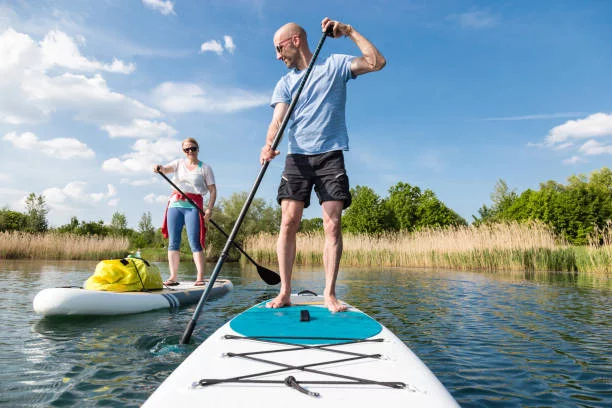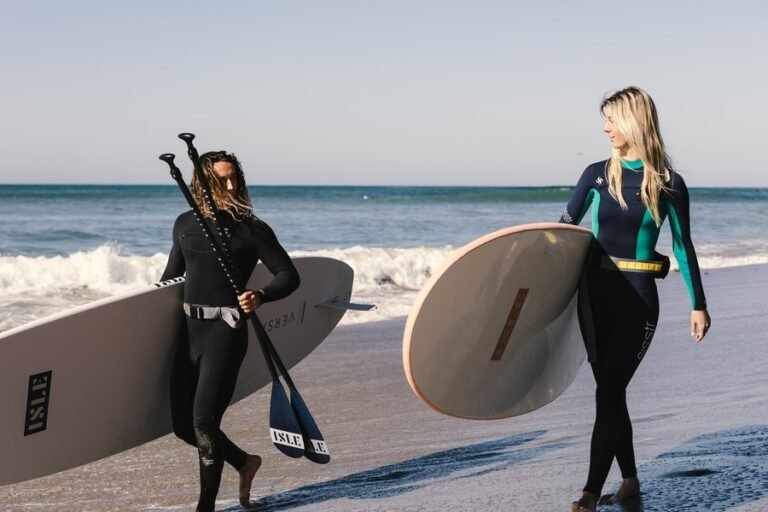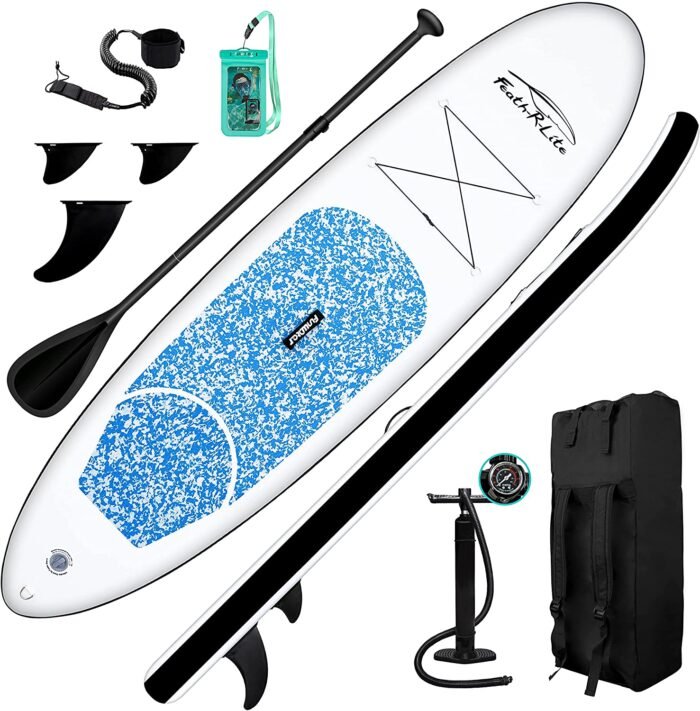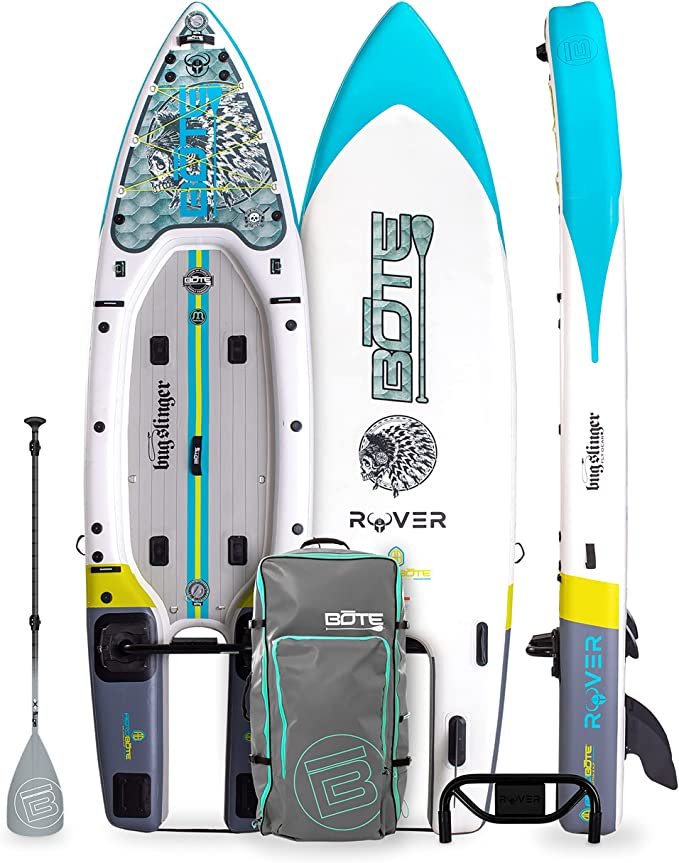Do You Need a Life Jacket on a Paddleboard?
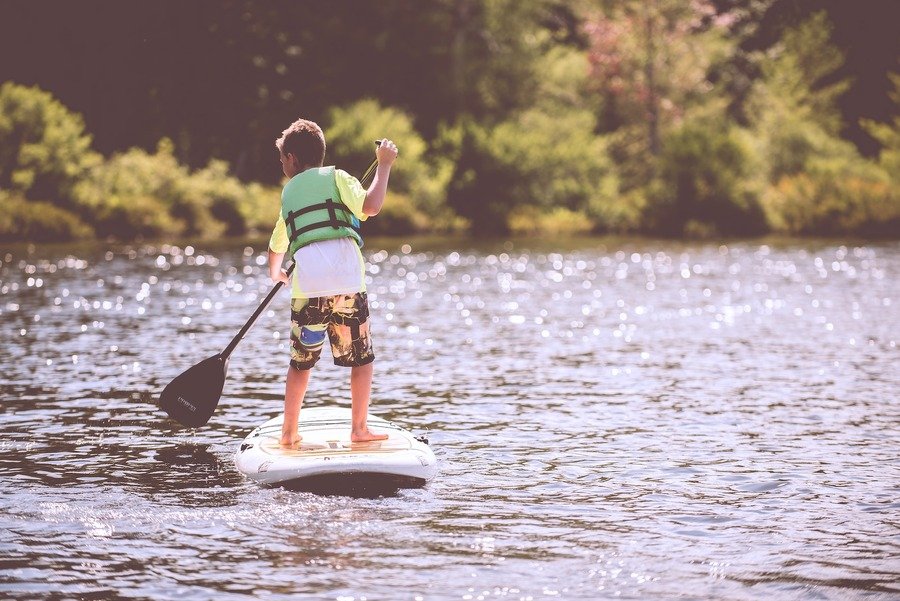
Imagine gliding along the serene waters, feeling the gentle rhythm of the paddle strokes, and basking in the warmth of the sun on your skin.
Paddle boarding is undoubtedly a tranquil and captivating experience that allows us to connect with nature in a unique way.
However, amidst this idyllic scene, a sobering fact cannot be ignored – water-related accidents happen, and they can happen to anyone.
Understanding How Paddleboarding Works
In water sports, paddle boarding, also referred to as SUP (Stand-Up Paddleboarding), has gradually gained popularity over the last few decades.
It involves moving across the water surface while standing or kneeling on a paddle board. This engaging and versatile activity provides a unique perspective on the water and the natural world below.
The versatility and accessibility of paddle boarding are the reasons behind its growing popularity. It serves a diverse spectrum of fans, from those looking for tranquil times on quiet lakes to thrill-seekers riding coastal waves.
It has drawn participants of all ages and fitness levels because it is a full-body exercise that also acts as a soothing hobby.
Types of Paddleboards
1. Rigid Paddle Boards: These boards are typically constructed from hard materials like fiberglass, epoxy, or wood. They offer excellent stability and are well-suited for various water conditions.
- Advantages: Rigid boards provide optimal performance and control, making them popular among experienced paddle boarders.
- Disadvantages: They can be bulky and challenging to transport and store.
2. Inflatable Paddle Boards: Inflatables have gained immense popularity due to their portability and ease of storage. Made from durable materials, they can be inflated for use and deflated for convenient transport.
- Advantages: Inflatables are incredibly portable, making them ideal for travelers and those with limited storage space.
- Disadvantages: They may lack the rigidity of traditional boards, affecting performance slightly.
Paddleboarding Environments
Paddle boarding isn’t confined to a single type of water body. Enthusiasts have embraced the sport in various aquatic environments, each offering a unique experience.
1. Lakes: Paddleboarding on calm, freshwater lakes provide a tranquil experience. It’s an excellent choice for beginners and those seeking relaxation.
2. Rivers: Navigating rivers adds an adventurous twist to paddle boarding. The flow and occasional rapids offer challenges for intermediate and advanced paddle boarders.
3. Oceans: Coastal paddle boarding provides the thrill of riding waves. It demands advanced skills and an understanding of tides and currents.
4. Ponds and Streams: Smaller water bodies like ponds and streams are perfect for exploring remote and picturesque locations.
5. Urban Waterways: Some urban dwellers have taken to paddle boarding in city canals and waterways, offering a unique urban perspective.
Safety Risks in Paddle Boarding
Common Hazards
While paddle boarding offers serene moments with nature, it’s essential to recognize the common hazards that paddle boarders may encounter. These hazards can turn a peaceful outing into a potentially dangerous situation.
1. Strong Currents: In rivers and coastal areas, powerful undercurrents can pose a serious risk. Paddleboarders may find themselves unexpectedly carried away from their intended route.
2. Weather Changes: Weather conditions can shift rapidly, catching even experienced paddle boarders off guard. Sudden storms, high winds, and lightning can turn a tranquil outing into a perilous one.
3. Collision Risks: In areas with boat traffic, collisions are a genuine concern. Boaters may not always see paddle boarders, especially in crowded waterways.
4. Wildlife Encounters: Depending on your location, encounters with wildlife, such as sharks or alligators, can present safety challenges.
Unpredictable Situations
One of the most critical aspects of paddle boarding safety is acknowledging the inherent unpredictability of the water.
1. Changing Weather: The weather can change rapidly, transforming calm waters into turbulent seas. Sudden winds, thunderstorms, and fog can create hazardous situations. Even in a familiar location, water conditions can vary from one day to another. Calm waters can become choppy, and seemingly gentle currents can hide dangerous undertows.
2. Inexperienced Paddlers: Paddle boarding attracts beginners and experienced enthusiasts alike. Inexperienced paddlers may lack the skills to navigate challenging conditions, increasing the risk of accidents.
3. Equipment Failures: Just like any other equipment, paddle boards and paddles can fail. A sudden break or malfunction can leave a paddleboarder stranded in the water.
Life Jackets: A Vital Safety Gear
Life jackets come in various styles to cater to different preferences and needs. Inflatable life jackets are compact and comfortable to wear.
They inflate when submerged in water, providing buoyancy. Inflatables are popular among experienced paddle boarders due to their minimal interference with movement.
Foam life jackets are traditional life jackets filled with foam and provide reliable buoyancy without the need for inflation. They are often recommended for beginners and those who prioritize simplicity and reliability.
Combining elements of both inflatables and foam, hybrid life jackets offer versatility. They provide buoyancy-like foam jackets but also include inflatable components for added comfort.
Legal Requirements of Life Jackets
1. State Regulations
Paddleboarding may be required by state and local authorities to wear life jackets. It is imperative that you are aware of and follow these rules. Fines and other penalties may be imposed for noncompliance.
Regulations can vary from one location to another. Some states may mandate life jacket usage only for certain age groups or in specific water conditions.
2. Age Restrictions
Age-related requirements for life jackets exist to protect vulnerable individuals. Many areas have strict age restrictions, requiring children to wear life jackets at all times while on the water, regardless of the activity.
While adults may have more flexibility, life jacket usage is still often recommended, especially in challenging water conditions.
Benefits of Wearing a Life Jacket
1. Buoyancy and Floatation
Life jackets are designed to keep paddle boarders afloat in case of a fall or accident. They provide the extra buoyancy needed to stay on the water’s surface, even when fatigued or injured.
2. Heat Retention
In cold water, hypothermia is a real concern. Life jackets not only keep you afloat but also help retain body heat. This can be a lifesaver in situations where exposure to cold water is prolonged.
3. Increased Visibility
Life jackets are typically brightly colored and equipped with reflective strips. This high-visibility design makes paddle boarders more conspicuous to boaters, reducing the risk of collisions, especially in crowded or low-visibility areas.
Life Jacket Selection and Maintenance
Choosing the Right Life Jacket
1. Sizing
Selecting the correct size for your life jacket is crucial for its effectiveness and your safety.
- Weight-Based Sizing: Life jackets are typically categorized by weight ranges. Refer to the manufacturer’s sizing chart to determine the range that matches your weight.
- Try Before You Buy: Whenever possible, try on the life jacket before purchasing. Make sure it fits snugly but allows for comfortable movement of your arms and torso.
- Adjustable Straps: Look for life jackets with adjustable straps. These allow you to fine-tune the fit to your body, ensuring it stays securely in place.
2. Type for Paddleboarding
Choosing the right type of life jacket for paddle boarding is essential.
- Inflatable Life Jackets: Inflatable life jackets are favored by experienced paddle boarders for their comfort and unobtrusive design.
- Foam Life Jackets: Foam life jackets are versatile and suitable for various paddle boarding conditions. They provide reliable buoyancy without the need for inflation and are often recommended for beginners and those expecting to encounter challenging water conditions.
Maintenance and Care
Proper maintenance ensures your life jacket remains in good condition.
1. Cleaning and Storage
- Rinse After Use: After each paddle boarding session, rinse your life jacket with fresh water to remove salt, sand, and debris. This prevents premature wear and maintains buoyancy.
- Air Dry: Hang your life jacket in a well-ventilated area to dry thoroughly before storing it. Avoid direct sunlight, as prolonged exposure can degrade materials.
- Store Properly: Keep your life jacket out of direct sunlight and extremely hot or cold conditions. It is better to hang it or put it flat instead of fold it since folding can cause creases that eventually degrade the fabric.
2. Checking for Damage
Regularly inspect your life jacket for signs of wear and tear.
- Torn or Frayed Fabric: Check for any tears, frayed edges, or loose stitching. If you observe any damage to the life jacket, replace or repair it.
- Buckles and Zippers: Make sure every zipper and buckle functions properly. Ensure that they fasten firmly by testing them from time to time.
- Inflatable Mechanism: If you use an inflatable life jacket, check the CO2 cartridge and firing mechanism. Ensure they are not damaged or corroded.
- Buoyancy: Test the buoyancy by wearing the life jacket in shallow water to ensure it still keeps you afloat effectively.
Life Jacket Alternatives
Personal Flotation Devices (PFDs)
Personal Flotation Devices (PFDs) are often considered as alternatives to traditional life jackets, but they have distinct characteristics:
- Buoyancy Type: PFDs provide buoyancy but may not offer the same level of floatation as life jackets. They are designed to help you stay afloat but may not keep you as high on the water.
- Freedom of Movement: PFDs are typically more lightweight and less restrictive than life jackets. They allow for more natural movement of the arms and torso, which can be advantageous for paddle boarding.
PFDs are often favored by individuals engaged in water sports where full mobility is essential, such as kayaking or paddle boarding in calm conditions.
When considering PFDs as an alternative for paddle boarding, it’s essential to weigh their pros and cons:
Pros
- Comfort: PFDs are generally more comfortable and less cumbersome, making them ideal for extended paddle board sessions.
- Freedom of Movement: PFDs allow for a wider range of motion, which is beneficial for paddle boarding, especially when performing yoga or other balance-intensive activities.
- Less Heat Retention: In warm weather, PFDs can be cooler to wear than traditional life jackets, reducing the risk of overheating.
Cons
- Buoyancy: PFDs might not offer as much buoyancy as life jackets, which could be problematic in choppy conditions or in an emergency.
- Visibility: PFD visibility may be lesser than that of vividly colored life jackets, which might be a safety risk, especially in locations with high boat traffic.
- Regulatory Compliance: Some regions may require the use of life jackets specifically and do not consider PFDs as a suitable alternative. It’s crucial to be aware of local regulations.
Leash Usage
While PFDs and life jackets serve as important safety gear, they are not mutually exclusive. It’s highly advisable to use a leash in conjunction with a life jacket or PFD.
- Preventing Separation: A leash keeps you connected to your paddle board. It keeps you from getting separated from your board in the event of a fall, which is especially helpful in windy situations or when you are at a distance from shore.
- Ease of Recovery: You can spend less time in the water if you fall off your board and are leash-attached to your life jacket or personal flotation device (PFD). This makes it quicker to retrieve your board and get back on.
- Overall Safety: The combination of a life jacket or PFD with a leash enhances your overall safety on the water. They work together to reduce the risks associated with paddle boarding.
Tips for Safe Paddleboarding
Paddleboarding is an exhilarating and serene water activity, but safety should always be a top priority. To ensure your paddleboarding adventures are not only enjoyable but also secure, consider these essential tips:
- Always Wear a Life Jacket
We cannot emphasize this enough: always wear a life jacket when paddle boarding. It is your lifeline on the water. Whether you prefer a traditional life jacket or a personal flotation device (PFD), having one on is non-negotiable.
It provides buoyancy, keeps you afloat in emergencies, and increases your visibility to others. Don’t compromise on safety – buckle up that life jacket before setting out.
- Weather Awareness
Before you head out for your paddleboarding session, take a moment to check the weather conditions. Weather can change rapidly, and being caught off guard by a sudden storm or strong winds can be dangerous.
Pay attention to wind forecasts, lightning warnings, and tide information. It’s better to postpone your outing than to risk getting caught in adverse weather.
- Skill Development
Enhance your paddleboarding skills by investing in training courses and regular practice. Courses can teach you essential techniques for balance, navigation, and safety.
Practicing in varying conditions will build your confidence and prepare you for unexpected challenges. Whether you’re a beginner or an experienced paddler, there’s always something new to learn.
- Emergency Preparedness
Prepare for the unexpected by carrying essential safety equipment. This includes a whistle to signal for help if needed and waterproof lights if you plan to paddle during dawn or dusk.
A leash is another crucial piece of equipment that prevents separation from your board. In emergencies, these items can make all the difference between a minor inconvenience and a serious incident.
- Buddy System
Whenever possible, paddle board with a friend or a group. The buddy system adds an extra layer of safety. If one person encounters trouble, the other can provide assistance or seek help if necessary. Plus, sharing the experience with a friend enhances the enjoyment of paddle boarding.

